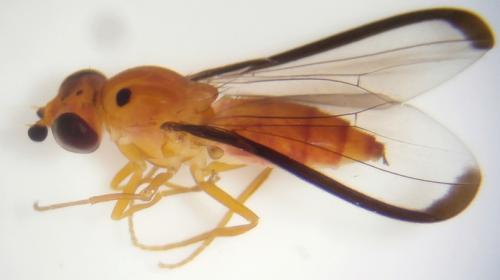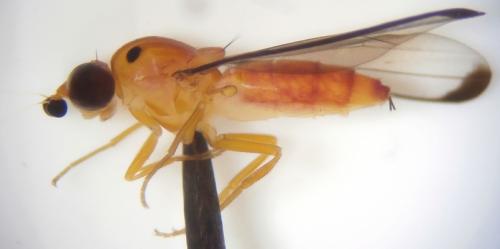Posted by HDumas on 17-04-2020 09:31
#1
Hello,
In the
Manual of Afrotropical Diptera (volume 1), one of the diagnostic features of Chloropids (cf. br. 11 p. 330) is
vein M4 usually with characteristic kink.
What is a "kink" on a vein?
Could this Chloropid from Ivory Coast be a
Pseudochromatopterum rileyi Deeming, 1981?

H. Dumas : Côte d'Ivoire : Man : -- : 29/09/2019
Altitude : NR - Taille : 4.2 mm
Réf. : 253535

H. Dumas : Côte d'Ivoire : Man : -- : 29/09/2019
Altitude : NR - Taille : 4.2 mm
Réf. : 253536
Is it a male or a female?
Edited by HDumas on 19-04-2020 09:26
Posted by von Tschirnhaus on 18-04-2020 12:18
#2
Pseudochromatopterum rileyi Deeming, 1981 (Chloropidae, Chloropinae) is the correct identification. Description in J. natural Hist. 15(5): 789-828 (on p. 799). The author of this post possesses the species from Ghana: 1 female, 13.x.1998, 2.5 km north of Hohoe, leg. Werner Barkemeyer. Altogether now 10 specimens are known 8 of them from the original description. Answer: The kink of vein M4 is typical for all world Chloropidae and marks the point where the lost anal cell (cup) touched with vein CuA2 the vein CuA1 = M3+4. In many chloropid images in diptera.info this kink is well to be seen and is partly also commented. The anal cell of Chloropidae was already lost in Eocene (Tertiary) fossils.
Posted by Dermochelys on 20-04-2020 08:35
#4
Dear von Tschirnhaus,
Thank you for these details.
Please could you tell me from where the type serie specimens were collected? To know if Ivory Coast could be a new country record.
Best wishes

